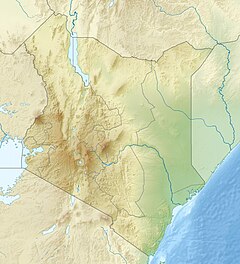Enkapune Ya Muto
From Wikipedia, the free encyclopedia
Archaeological site in Kenya
 location in Kenya | |
| Alternative name | Twilight Cave |
|---|---|
| Location | Mau Escarpment of Kenya |
| Region | Kenya |
| Coordinates |  0°50′0″S 36°09′0″E / 0.83333°S 36.15000°E / -0.83333; 36.15000Coordinates: 0°50′0″S 36°09′0″E / 0.83333°S 36.15000°E / -0.83333; 36.15000Coordinates:  0°50′0″S 36°09′0″E / 0.83333°S 36.15000°E / -0.83333; 36.15000 0°50′0″S 36°09′0″E / 0.83333°S 36.15000°E / -0.83333; 36.15000 |
Part of a series on the |
|---|
| History of Kenya |
 |
|
|
Pleistocene
|
|
Neolithic
|
|
African iron age
|
|
Swahili city states
|
|
Portuguese and Omani period
|
|
British Colonial Period
|
|
Early post Independence
|
|
Moi Era
|
|
Recent history
|
|
|
|
Enkapune Ya Muto, also known as Twilight Cave, is a Late Stone Age site on the Mau Escarpment of Kenya. Beads made of perforated ostrich egg shells found at the site have been dated to 40,000 years ago. The beads found at the site represent the early human use of personal ornaments.[1][2][3]
See also[]
- List of Stone Age art
- Eburran industry
References[]
- ^ "Enkapune Ya Muto Rockshelter - Enkapune Ya Muto". Archaeology.about.com. Archived from the original on 3 December 2013. Retrieved 7 March 2017.
- ^ Marean, Curtis W. (1992). "Hunter to herder: large mammal remains from the hunter-gatherer occupation at Enkapune Ya Muto rock-shelter, Central Rift, Kenya". The African Archaeological Review. 10: 65–127. doi:10.1007/BF01117697. S2CID 129526564.
- ^ Ambrose, S (1997). "Chronology of the Later Stone Age and Food Production in East Africa". Journal of Archaeological Science. 25 (4): 377–392. doi:10.1006/jasc.1997.0277.
External links[]
Prehistoric technology | |||||||||||||||||||||
|---|---|---|---|---|---|---|---|---|---|---|---|---|---|---|---|---|---|---|---|---|---|
| |||||||||||||||||||||
| |||||||||||||||||||||
| |||||||||||||||||||||
| |||||||||||||||||||||
Prehistoric cave sites, rock shelters and cave paintings | |||||||||||||||||||||||||||||||||||||||||||||||||||||||||||||||
|---|---|---|---|---|---|---|---|---|---|---|---|---|---|---|---|---|---|---|---|---|---|---|---|---|---|---|---|---|---|---|---|---|---|---|---|---|---|---|---|---|---|---|---|---|---|---|---|---|---|---|---|---|---|---|---|---|---|---|---|---|---|---|---|
| |||||||||||||||||||||||||||||||||||||||||||||||||||||||||||||||
| |||||||||||||||||||||||||||||||||||||||||||||||||||||||||||||||
| |||||||||||||||||||||||||||||||||||||||||||||||||||||||||||||||
| |||||||||||||||||||||||||||||||||||||||||||||||||||||||||||||||
| |||||||||||||||||||||||||||||||||||||||||||||||||||||||||||||||
| |||||||||||||||||||||||||||||||||||||||||||||||||||||||||||||||
| |||||||||||||||||||||||||||||||||||||||||||||||||||||||||||||||
This African history–related article is a stub. You can help Wikipedia by . |
- v
- t
Retrieved from ""
Categories:
- Paleoanthropological sites
- Archaeological sites in Kenya
- Rock shelters
- African history stubs
Hidden categories:
- Articles with short description
- Short description matches Wikidata
- EngvarB from March 2014
- Use dmy dates from March 2014
- Coordinates on Wikidata
- All stub articles